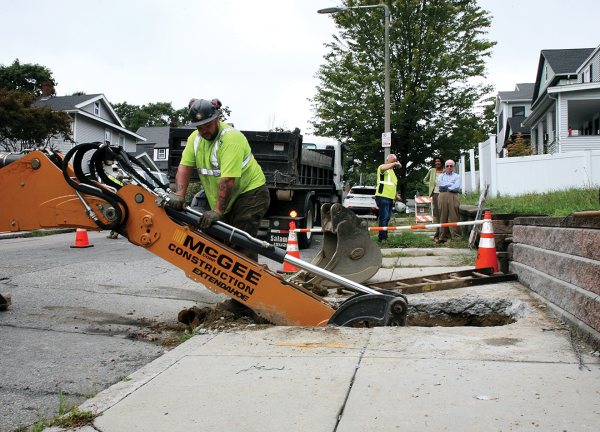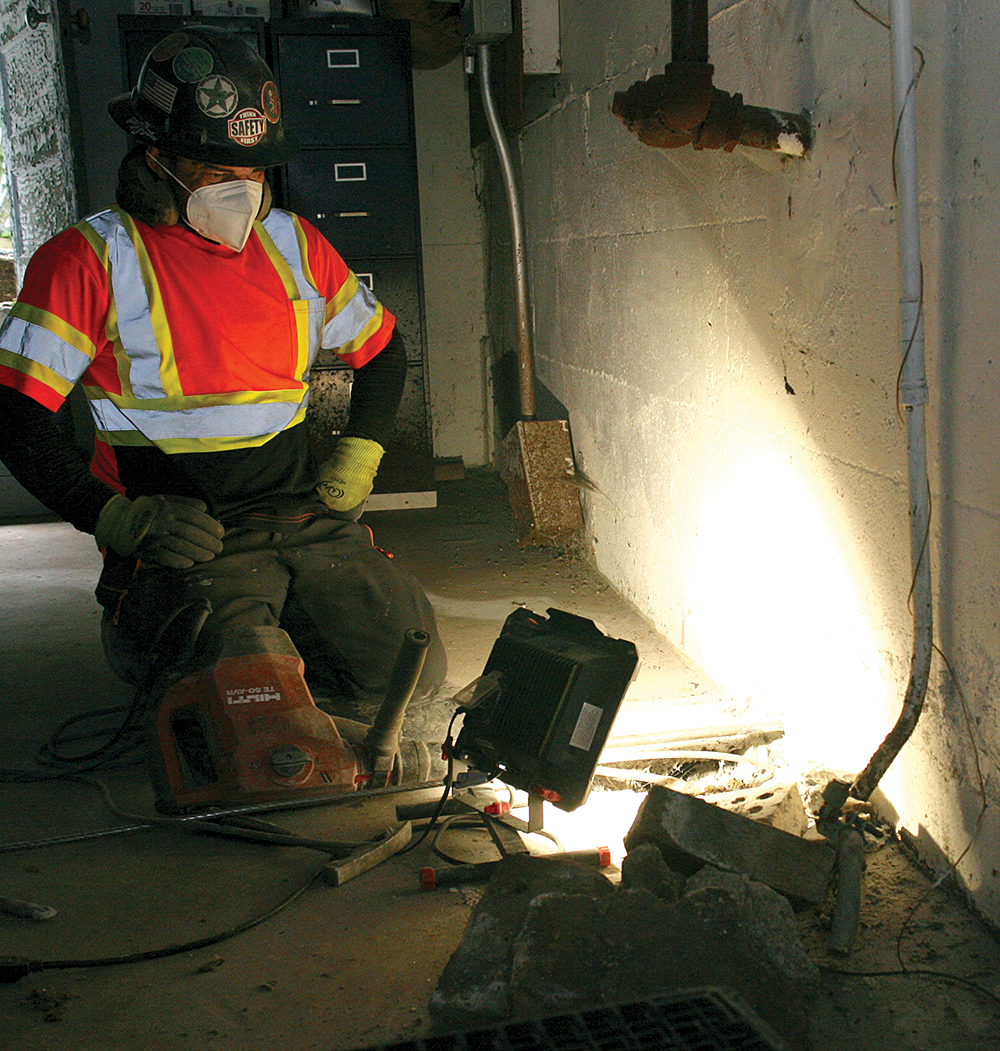October 9, 2024

Workers positioned machinery to pull out a lead service line on Standard Street in late August while they pulled through a new copper service line from the basement of the home. Most jobs only take a few hours and, due to federal and state funding, are now free to the customer. Seth Daniel photos
Getting lead water pipes removed has never been so affordable – in fact, it is free via a citywide program targeting owners who want to eliminate the lead health concern from their homes. The removal effort is a top priority of the Boston Water and Sewer Commission (BWSC) and the Boston Public Health Commission (BPHC), both said.
Armed with a multi-million-dollar federal grant from the pandemic-related Infrastructure and Investment in Jobs Act and state grant funding and focused on Dorchester, Mattapan, and Roxbury in particular, BWSC is conducting heavy outreach to the remaining holdouts and to those with complicated, expensive jobs that homeowners deferred in the past. In the past, such jobs could cost homeowners thousands of dollars, but all of them are now free.
“It’s really for public health,” said Irene McSweeney, a Dorchester resident and BWSC’s chief of special operations. “We care about our customers and want to make sure we’re providing [them] the best water quality we can. That means getting rid of lead service lines at every address in the city…Any barriers [to that goal] that exist, we want to get them out of the way. That’s the plan.”
Lead service lines are a vestige of the past, when most pipes were constructed of lead, a substance now known to cause brain damage with exposure – particularly to children. The problem is particularly a risk with underground pipes running from water mains in the street into customer homes. Pipes that contained lead were installed in Boston until 1934, and can be fully lead, lined with lead, or soldered together with lead.
The replacement of the portion of the pipe from the water main to the back of the sidewalk is the responsibility of BWSC, but the remaining portion – from the sidewalk into the home – is on the customer’s dime. Costs to the homeowner for the most complicated jobs in the past could surpass $10,000, BWSC said.

Joe Joyce, of BWSC, supervised the job on Standard Street as the team got ready to pull the lead line out of the ground. Seth Daniel photos
It is estimated that citywide there are some 10,300 public and private pipes that need more investigation or testing for lead content.
In Dorchester (the neighborhood with the largest numbers of lead lines) there are 181 public lines and 845 private lines that may need replacement. In Mattapan, there are 24 public lines and 141 private lines of that kind. Of the private line investigations done recently, BWSC said, 32 percent have shown lead pipes.
Given that, goals to eliminate lead service lines by 2027 have become a priority and making it free in the summer of 2023 due to the new federal and state funding has been the biggest step forward. “Even for the really expensive ones, we’re really breaking even,” said McSweeney.
Paul Shoemaker, director of the Environmental and Occupational Health Division at the BPHC, has been a partner in the effort on the health side. He said that while most lead poisoning is found in children living in older homes who have eaten lead paint chips, there is a risk in lead service lines, too.
“The Boston Childhood Lead Poisoning Prevention Program, whose mission is to eliminate lead poisoning in Boston, provides community outreach, in-home education, and case management for families whose children have been impacted by lead, and inspection and enforcement of the Massachusetts Lead Law,” he said.
Exposure to lead can cause a wide array of short- and long-term health impacts because lead builds up over time and can if not attended to cause permanent damage.
Some of the issues are learning and cognitive impairments, hearing/speech problems, behavioral changes like increased aggression, reproductive problems, memory impairment, high blood pressure, kidney damage, seizures, among others, according to BPHC.
Shoemaker said lead service lines or lead plumbing in the home can also contaminate drinking water because “water sitting in a lead service line for a long time, such as overnight when no one in the house is using water, can dissolve lead from the pipe into the water. Drinking that water, or using it to mix baby formula, delivers the lead into a child’s body and causes harm.” He noted that “even though most houses in Boston are not attached to a lead line, there are still too many that are.”

A worker from the Boston Water and Sewer Commission’s lead service line replacement team prepared a lead pipe for removal from a basement in Mattapan’s Standard Street in late August while guiding in the new copper line that will replace it.
Since 2023, his department has partnered with BWSC to spread the word. A pilot program by BWSC over the last year in Roxbury and Mattapan included door-to-door visits to raise awareness, and likewise, BPHC has had an employee spreading information in Dorchester.
One homeowner on Mattapan’s Standard Street recently jumped on board because of door-to-door outreach and agreed to replace a lead service line running from the sidewalk into his basement.
One late August morning, project manager Joe Joyce and a crew set up to begin digging up the sidewalk where the service line runs into the home. That work can be quicker than most might think, with crews doing two or three replacements a day. Almost 90 percent of the time, the work involves simply using a backhoe to pull out the lead line while simultaneously pulling a new copper line to the street from the basement. Once all is reattached, the problem is resolved.
“The majority of the locations that require lead water service removal, we’re not digging up the entire trench,” said McSweeney. “A lot of times we don’t even have to excavate on the owner’s property or in the front yard. Most of the time we’re in and out in about four to six hours. The more difficult ones, including long services, can take a full day. It’s pretty non-intrusive.”
On Standard Street, an old tree root made the job a bit tougher, so crews had to excavate a trench to remove the line and put in the new copper line. Still, lead-free water service was restored by the end of the day.
McSweeney said they are looking to address all lead service removal jobs but have also focused on more complicated jobs – those with service lines more than 60 feet long, or buildings that have pipes that aren’t in straight lines. These are the jobs that were too expensive for homeowners in the past but are now free.
“In the past it could have been more than $6,000 and at times it was as much as $10,000 for them,” said McSweeney. “Some of those customers said they didn’t want to spend that kind of money. We went back to them as a priority now that the work is free, and we have had great success with them.”
At least 20 new replacements have come from those who declined previously. One of them was David Burson of Alban Street on Dorchester’s Ashmont Hill. When he and his wife moved into their home in 1986, it needed a lot of work and updates, one of them being lead service lines. But at the time, there were more important things to accomplish, so lead water lines took a backseat.
“We knew the option of replacement was out there, but it wasn’t subsidized, and we thought we’d hold out and see what happened down the line,” said Burson, who noted that he and his wife raised two kids in the home over 38 years. “We had lead lines the whole time…They survived the perils of living with lead water service…We knew it was lead and took all the precautions with flushing the lines and utilizing filters, but we preferred, obviously, not to have lead service coming into the home.”
Burson said they heard about the free aspect through an advertisement in a local newspaper and decided to act. As it turned out, BWSC was able to take on their complicated project, which required a trench through the front yard, but overall, it only lasted a few days and wasn’t overly disruptive.
“They stuck with it and got it done,” Burson said. “By and large, it was a really positive experience.”
These sorts of experiences are what McSweeney said keeps them going as they reach out and convince absentee landlords, skeptical homeowners, and others who don’t even know the lead issue exists to act. “The hardest part is getting the property owner on board with us,” she said.


